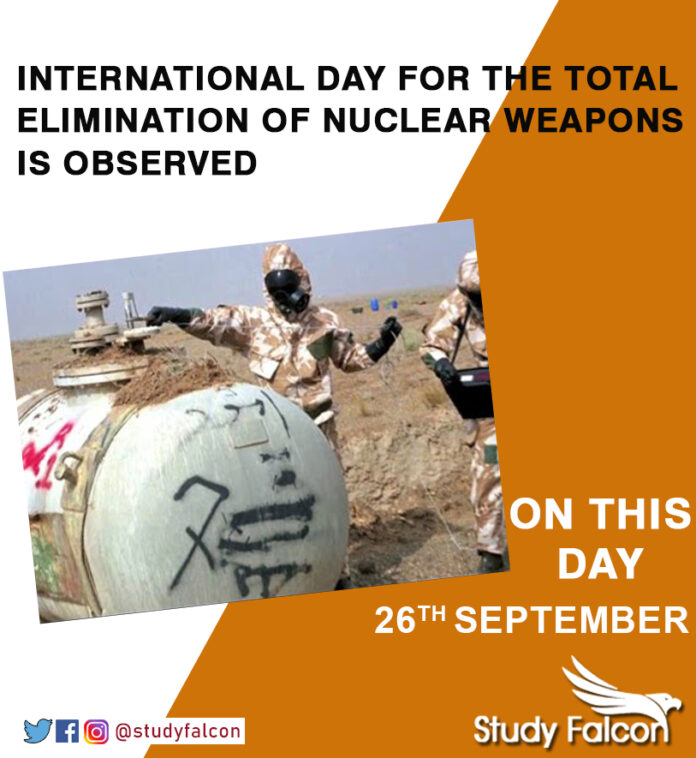Achieving global nuclear disarmament is one of the oldest goals of the United Nations. It was the subject of the General Assembly’s first resolution in 1946, which established the Atomic Energy Commission, which was dissolved in 1952, with a mandate to make specific proposals for the control of nuclear energy and the elimination of atomic weapons and all other major weapons adaptable to mass destruction.
Since nuclear weapons testing began on 16 July 1945, nearly 2,000 have taken place. In the early days of nuclear testing little consideration was given to its devastating effects on human life, let alone the dangers of nuclear fallout from atmospheric tests. Hindsight and history have shown us the terrifying and tragic effects of nuclear weapons testing, especially when controlled conditions go awry, and in light of the far more powerful and destructive nuclear weapons that exist today.
In 1978, the first Special Session of the General Assembly Devoted to Disarmament further recognized that nuclear disarmament should be the priority objective in the field of disarmament.

In 2017, ICAN came up with an international treaty on prohibition of Nuclear Weapons. The treaty was first in its kind. It is an international agreement to prohibit nuclear weapons. Till August 29, 2019, only 26 states have ratified it. In the UN, a resolution can be ratified only if a minimum of 50 countries ratify it. India denounced from voting in favor of the resolution.
On 2 December 2009, the 64th session of the United Nations General Assembly declared 29 August the International Day against Nuclear Tests by unanimously adopting resolution 64/35. The resolution calls for increasing awareness and education “about the effects of nuclear weapon test explosions or any other nuclear explosions and the need for their cessation as one of the means of achieving the goal of a nuclear-weapon-free world.” The resolution was initiated by the Republic of Kazakhstan, together with a large number of sponsors and cosponsors with a view to commemorating the closure of the Semipalatinsk Nuclear Test site on 29 August 1991. 2010 marked the inaugural commemoration of the International Day against Nuclear Tests. In each subsequent year, the day has been observed by coordinating various activities throughout the world, such as symposia, conferences, exhibits, competitions, publications, lectures, media broadcasts and other initiatives.
The General Assembly declared the International Day in December 2013, in its resolution 68/32 as a follow-up to the high-level meeting of the General Assembly on nuclear disarmament held on 26 September 2013, in New York.
This Day provides an occasion for the world community to reaffirm its commitment to global nuclear disarmament as a priority.

The purpose of the International Day is to further the objective of the total elimination of nuclear weapons through enhancing public awareness and education about the threat posed to humanity by nuclear weapons and the necessity for their total elimination.
Today nearly 14,000 nuclear weapons remain. Countries possessing such weapons have well-funded, long-term plans to modernize their nuclear arsenals. More than half of the world’s population still lives in countries that either have such weapons or are members of nuclear alliances. On 2 August 2019, the United States’ withdrawal spelled the end of the Intermediate-Range Nuclear Forces Treaty, through with the United States and the Russian Federation had previously committed to eliminating an entire class of nuclear missiles.

On 14 January 2020, the E3 (France, Germany, the United Kingdom) referred the matter of phased withdrawal of nuclear-related commitments under the Joint Comprehensive Program of Action (JCPOA) by the Islamic Republic of Iran to the JCPOA’s Joint Commission, invoking the dispute resolution mechanism of the agreement. On 27 March, 2020, the Tenth Review Conference of the Parties to the Treaty on the Non-Proliferation of Nuclear Weapons was postponed to a later date due to COVID-19 pandemic, as soon as the circumstances permit, but no later than April 2021. On 13 April, the Fourth Conference of Nuclear-Weapon-Free Zones and Mongolia was postponed to a period in 2021 to be decided by the General Assembly at its seventy-fifth session. On 2 July, the Islamic Republic of Iran referred the implementation issues with the E3 (France, Germany, the United Kingdom) to the JCPOA’s Joint Commission, invoking the dispute resolution mechanism of the agreement.
To help bring the CTBT into force, NGOs, civil society and members of the public, especially in those countries that must ratify the Treaty for it to enter into force, can urge their – and other – governments and parliaments to sign and ratify the treaty. They can also urge their governments to endorse the Secretary-General’s Five Point Proposal for Nuclear Disarmament, which includes bringing the CTBT into force and consideration of negotiating a nuclear weapons convention, backed by a strong system of verification, as has long been proposed at the United Nations.
The UN holds various events in order to educate people around the world about the importance of eliminating nuclear weapons. On this day, the UN also seeks to spread awareness about the threat nuclear weapons pose to humanity. It’s the goal of the UN that education and awareness will mobilize countries to get rid of their nuclear weapons.










